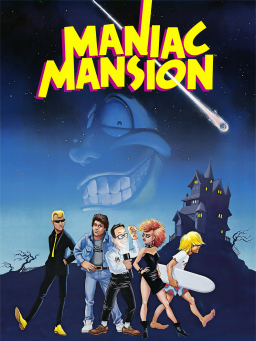
Maniac Mansion is a 1987 graphic adventure video game developed and published by Lucasfilm Games. It follows teenage protagonist Dave Miller as he attempts to rescue his girlfriend Sandy Pantz from a mad scientist, whose mind has been enslaved by a sentient meteor. The player uses a point-and-click interface to guide Dave and two of his six playable friends through the scientist's mansion while solving puzzles and avoiding dangers. Gameplay is non-linear, and the game must be completed in different ways based on the player's choice of characters. Initially released for the Commodore 64 and Apple II, Maniac Mansion was Lucasfilm Games' first self-published product.

A Boy and His Blob: Trouble on Blobolonia is a puzzle-platform game developed by Imagineering and published by Absolute Entertainment for the Nintendo Entertainment System (NES). The video game was released in North America in 1989, in Europe by Nintendo in 1991 and in Japan by Jaleco in 1991. A Boy and His Blob follows an unnamed male protagonist and his shapeshifting blob friend on their adventure to save the planet of Blobolonia from the clutches of an evil emperor.
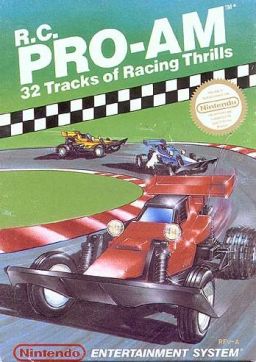
R.C. Pro-Am is a racing video game developed by Rare and published by Nintendo for the Nintendo Entertainment System. It was released in North America in February 1988, and then in Europe on April 15. Presented in an overhead isometric perspective, a single player races a radio-controlled car around a series of tracks in vehicular combat. Each track qualifies its top three racers for the next track. Collectible power-up items improve performance, hazards include rain puddles and oil slicks, and missiles and bombs can temporarily disable opponents. Originally titled Pro Am Racing, it was ported to the Sega Genesis in 1992 as Championship Pro-Am, an enhanced remake with enhanced graphics and additional features. R.C. Pro-Am spawned two sequels: Super R.C. Pro-Am in 1991, and R.C. Pro-Am II in 1992.
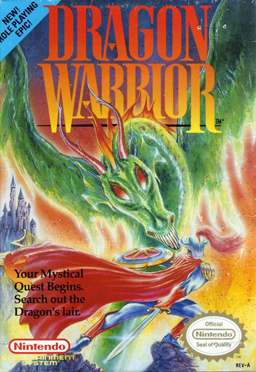
Dragon Quest, titled Dragon Warrior when initially localized to North America, is a role-playing video game developed by Chunsoft for the Nintendo Entertainment System. It was released by Enix in Japan in 1986 and by Nintendo in North America in 1989. It is the first game in the Dragon Quest video game series. Dragon Quest has been ported and remade for several video game platforms, including the MSX, MSX2, PC-9801, Super Famicom, Game Boy Color, Nintendo 3DS, PlayStation 4, mobile phones, and Nintendo Switch as of 2019. The player controls the hero character who is charged with saving the Kingdom of Alefgard and rescuing its princess from the evil Dragonlord. Dragon Warrior's story became the second part in a trilogy, with several spinoff anime and manga series.
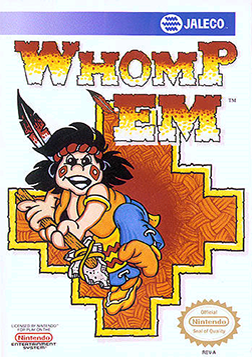
Whomp 'Em, the North American version of the Japanese game Saiyūki World 2: Tenjōkai no Majin (1990), is a platform game released on the Nintendo Entertainment System in March 1991.

Snake Rattle 'n' Roll is a platform video game developed by Rare. It was published by Nintendo and released for the Nintendo Entertainment System in North America in July 1990 and in Europe on March 27, 1991. The game features two snakes, Rattle and Roll, as they make their way through eleven 3D isometric levels. A Mega Drive version was released by Sega in June 1993 with an extra level. Snake Rattle 'n' Roll was developed by Rare members Tim Stamper and Mark Betteridge. The music was composed by David Wise and was inspired by "Shake, Rattle and Roll" and other 1950s-era songs.

Wizards & Warriors, titled Densetsu no Kishi Elrond in Japan, is an action platform video game developed by Rare and published by Acclaim Entertainment and Jaleco for the Nintendo Entertainment System. It was released in North America in December 1987, and in Europe on January 7, 1990. The player controls Kuros, "Knight Warrior of the Books of Excalibur", as he sets out in the Kingdom of Elrond to defeat the evil wizard Malkil. Malkil holds the princess of Elrond captive in Castle IronSpire, deep within the forests of Elrond. The player fights through forests, tunnels, and caves, while collecting keys, treasure, weapons, and magic items.
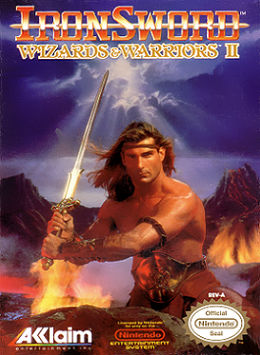
Ironsword: Wizards & Warriors II is a platforming action-adventure video game for the Nintendo Entertainment System (NES) developed by UK-based company Zippo Games, a subsidiary of Rare. The game was published by Acclaim and released in North America in December 1989 and in Europe on March 27, 1991. It is the sequel to Rare's 1987 title Wizards & Warriors. In Ironsword, the player controls the knight warrior Kuros as he ventures in the land of Sindarin. He must defeat the evil wizard Malkil, who has assumed the elemental forms of Earth, Wind, Fire, and Water. Kuros must collect the parts of and assemble the legendary "IronSword" in order to defeat Malkil, who resides at the top of IceFire Mountain.
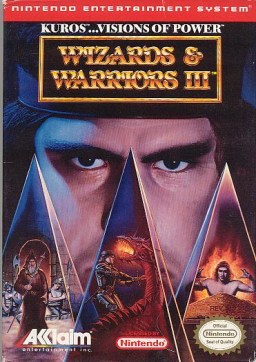
Wizards & Warriors III: Kuros - Visions of Power is a platforming and adventure video game for the Nintendo Entertainment System (NES). It was developed by UK-based company Zippo Games for Rare; it was published by Acclaim and released in North America in March 1992 and in Europe on January 21, 1993. It is the third and final installment in the Wizards & Warriors series and is the sequel to the 1989 title Ironsword: Wizards & Warriors II; it also follows the 1990 Game Boy release Wizards & Warriors X: The Fortress of Fear.

Ninja Gaiden III: The Ancient Ship of Doom is a side-scrolling platform video game developed and published by Tecmo. It was released in Japan on June 26, 1991 for the Famicom and in North America in August for the Nintendo Entertainment System (NES). The NES version was not released in Europe. It was later ported to the Atari Lynx by Atari Corporation and released in 1993 in North America and Europe, the European version retaining the North American Ninja Gaiden III title. It was also re-released as part of its Ninja Gaiden Trilogy Super NES compilation in 1995 in Japan and North America. Long after, it was released for the Virtual Console service in North America on February 18, 2008 for the Wii and in North America and Europe on November 28, 2013 and January 23, 2014 respectively for the Nintendo 3DS. It was designed by Masato Kato, who took over for Hideo Yoshizawa—designer of the first two games in the NES series.

R.C. Pro-Am II is a racing video game developed by Rare and released by Tradewest for the Nintendo Entertainment System on December 11, 1992. The game is the sequel to the 1988 R.C. Pro-Am and features similar gameplay with a wider variety of tracks, currency-based vehicle and weapon upgrades, and bonus stages. In R.C. Pro-Am II, four players, either human or artificial intelligence, race on a series of tracks to finish first while avoiding obstacles and hazards. The winner receives race points and money. The game features a multiplayer mode in which up to four human players can compete against each other simultaneously.

Mega Man: Dr. Wily's Revenge or in Japan as Rockman World is an action-platform video game by Capcom for the Nintendo Game Boy. It is the first game in the handheld series of the Mega Man franchise. It was released in Japan on July 26, 1991, and was localized in North America that December and in Europe the following year. The game continues the adventures of the android hero Mega Man as he once again confronts the evil Dr. Wily, who has dispatched his revived "Robot Masters" and a new "Mega Man Killer" named Enker.

Cyber Stadium Series—Base Wars is a baseball video game for the Nintendo Entertainment System (NES).

Wizards & Warriors X: The Fortress of Fear is a 1990 side-scrolling platforming video game developed by UK-based company Rare and published by Acclaim Entertainment for the Game Boy handheld game console. Taking place after the events in Ironsword: Wizards & Warriors II, the game features the knight warrior Kuros; he sets out to the Fortress of Fear to defeat the evil wizard Malkil, who, after 17 years of dormancy, has captured Princess Elaine and has imprisoned her there.
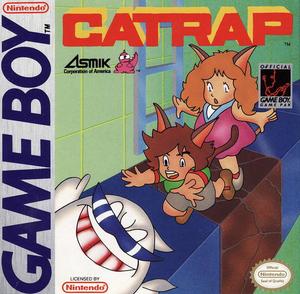
Catrap, known as Pitman in Japan, is a puzzle-platform game developed for the Sharp MZ-700 computer in 1985 and published by Asmik for the Nintendo Game Boy in 1990. The Game Boy version was rereleased on the Nintendo 3DS Virtual Console in October 2011. Destructoid credits the game with using a time-rewind mechanic before games like Blinx, Prince of Persia: The Sands of Time, and Braid.
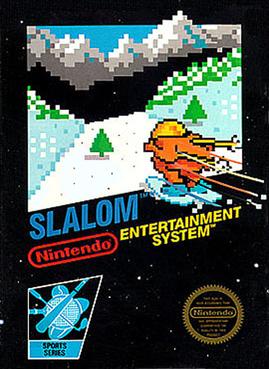
Slalom, originally released as VS. Slalom, is a skiing sports video game developed by Rare and published by Nintendo in 1986 for the Nintendo VS. System in arcades. It was then released for the Nintendo Entertainment System in North America in March 1987 and in Europe later that year. The player races in a series of downhill slalom skiing runs while navigating past flags and obstacles before time expires. It was developed by Tim and Chris Stamper and its music was composed by David Wise.
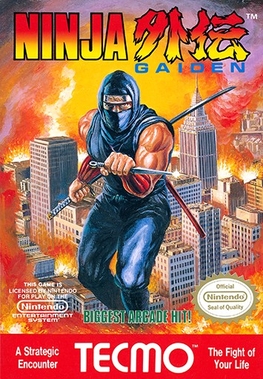
Ninja Gaiden, released in Japan as Ninja Ryūkenden and as Shadow Warriors in Europe, is an action-platform video game developed and published by Tecmo for the Nintendo Entertainment System. Its development and release coincided with the beat 'em up arcade version of the same name. It was released in December 1988 in Japan, in March 1989 in North America, and in August 1991 in Europe. It has been ported to several other platforms, including the PC Engine, the Super NES, and mobile phones.
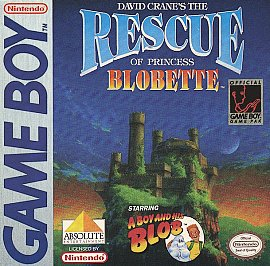
The Rescue of Princess Blobette is a video game for the Game Boy and the sequel to the Nintendo Entertainment System (NES) game A Boy and His Blob: Trouble on Blobolonia. It was published in North America by Imagineering's parent company Absolute Entertainment and in Japan by Jaleco. It was published by Nintendo in Europe.
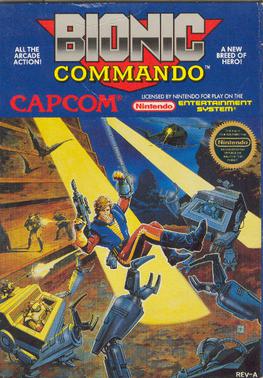
Bionic Commando, originally released as Hitler's Resurrection: Top Secret in Japan, is a platform game released by Capcom for the Family Computer and Nintendo Entertainment System in 1988. It is based on the 1987 arcade game Bionic Commando.
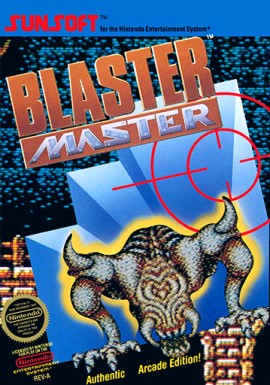
Blaster Master is a platform and run and gun video game released by Sunsoft for the Nintendo Entertainment System. It is a localized version of a Japanese Famicom game titled Chō Wakusei Senki Metafight, which was released on June 17, 1988. The game was released in North America in November 1988 and in Europe on April 25, 1991. The game is the first in the Blaster Master series, and it spawned two spin-off games as well as two sequels.





















